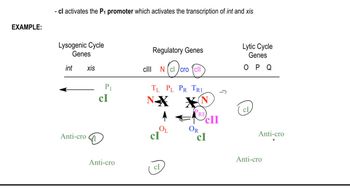Here are the essential concepts you must grasp in order to answer the question correctly.
Lytic and Lysogenic Cycles
The lytic and lysogenic cycles are two distinct pathways that bacteriophages, like λ phage, can follow after infecting a bacterial host. In the lytic cycle, the phage replicates rapidly, leading to the destruction of the host cell and the release of new phage particles. In contrast, the lysogenic cycle involves the integration of the phage DNA into the host genome, allowing it to replicate along with the host cell without causing immediate harm.
Recommended video:
Decision Between Lytic and Lysogenic Cycles
cI Gene Function
The cI gene in λ phage encodes a repressor protein that is crucial for maintaining the lysogenic state. This protein binds to the operator region of the phage genome, inhibiting the expression of genes required for the lytic cycle. When cI is functional, it promotes lysogeny by preventing the activation of lytic genes, thus allowing the phage to coexist with the host.
Recommended video:
Mutations and Gene Inactivation
Mutations that inactivate the cI gene can disrupt the balance between the lytic and lysogenic cycles. If cI is nonfunctional, the repressor cannot inhibit lytic gene expression, leading to the activation of the lytic cycle. This results in the phage entering a lytic phase, causing cell lysis and the release of new phage particles, rather than integrating into the host genome and remaining dormant.
Recommended video:
 Verified step by step guidance
Verified step by step guidance Verified video answer for a similar problem:
Verified video answer for a similar problem:



 4:29m
4:29m